GLOBAL INSTABILITY OF MULTI-DIMENSIONAL PLANE SHOCKS FOR ISOTHERMAL FLOW*
Ning-An LAI (赖宁安)
College of Mathematics and Computer Science,Zhejiang Normal University,Jinhua 321004,China Department of Mathematics,Lishui University,Lishui 323000,China
E-mail:ninganlai@lsu.edu.cn
Wei XIANG (向伟)
Department of Mathematics,City University of Hong Kong,Kowloon,Hong Kong 999077,China
E-mail:weixiang@cityu.edu.hk
Yi ZHOU (周忆)
School of Mathematical Sciences,Fudan University,Shanghai 200433,China
E-mail:yizhou@fudan.edu.cn
Abstract In this paper,we are concerned with the long time behavior of the piecewise smooth solutions to the generalized Riemann problem governed by the compressible isothermal Euler equations in two and three dimensions.A non-existence result is established for the fan-shaped wave structure solution,including two shocks and one contact discontinuity which is a perturbation of plane waves.Therefore,unlike in the one-dimensional case,the multi-dimensional plane shocks are not stable globally.Moreover,a sharp lifespan estimate is established which is the same as the lifespan estimate for the nonlinear wave equations in both two and three space dimensions.
Key words Blow-up;global solution;instability;shock;contact disctinuity;Euler equations;isothermal;generalized Riemann problem;nonlinear wave equations
1 Introduction
We are concerned with the non-existence of global solutions of the generalised Riemann problem governed by the compressible isothermal Euler equations.More precisely,we prove that the multi-dimensional (N=2,3) plane shocks are not stable in the global sense with respect to a smooth perturbation.
It is well-known that smooth solutions of the compressible Euler equations with some compression assumption will generate singularity in finite time no matter how small the initial data([1–3]).Therefore,it is natural and important to study the Cauchy problem with discontinuous initial data.For the one-dimensional case,a satisfactory theory on the global existence and stability of the Cauchy problem has been established by many mathematicians ([4–6]).However,theB.V.space is not a well-posed space for the Cauchy problem in multidimensions.As a result,almost all efforts have been focused on the multidimensional Riemann problem ([7–16]) or the structural stability of important physical problems introduced in Courant-Friedrichs’classic book[17],for example,the supersonic flow over a wedge or cone ([18–32]).
The multidimensional Riemann problem of the compressible Euler equations,which plays a prominent role in the theory of conservation laws,is one of the core and most challenging problems in the mathemaical theory of conservation laws.One important problem is the generalized Riemann problem,which studies the Cauchy problem with discontinuous initial data along a smooth curve.If the data is assumed to be smooth up to the curve,then we expect the solution to be of a fan-shape structure.The generalized Riemann problem can also be regarded as the stability of the Riemann solutions of the Cauchy problem with two constant states separated by a hyperplane.There is a lot of literature on the local existence of the generalized Riemann problem,for example,Blokhin[33,34]and Majda[35,36]for the strong shock,Metivier[37]for the weak shock,Alinhac[38]for the rarefaction wave,Coulombel-Secchi[39]for the two-dimensional vortex sheet,and[40]for the two dimensional composited waves which can be shocks,rarefaction waves or vortex sheets.
A natural question arises is:what about the global existence of solutions of the generalized Riemann problem?As far as we know,there are few results on the global existence of those waves except for the ones on the unsteady potential flow equation inn-dimensional spaces (n≥5,see[41]) or in special space-time domains for the potential flow.It is therefore of great significance to study the global behaviour of the solutions of the generalized Riemann problem from both the mathematical and physical point of view.In this paper,we will show that the solutions of the generalized Riemann problem (if they exist locally and are a perturbation of plane shocks) cannot exist globally for the two and three dimensional cases,if the flow is isothermal.This means that the plane Riemann solutions are not stable globally with respect to a smooth perturbation.Based on this,in order to obtain the global stability,we should think about the generalized Riemann problem in a weak sense.Moreover,the lifespan estimate,which is consistent with the lifespan estimate for the nonlinear wave equations,is also obtained;the result is different from the one dimensional case,in which the global existence is established ([42,43]).
2 Generalized Riemann Problem and Main Result
The multidimensional inviscid compressible flow is governed by the following Euler equation:

Hereρ,pand u are density,pressure and velocity,respectively.For the isothermal flow,the pressure and density satisfy the thermodynamic relation thatp=ρ.In this paper,we are concerned with the global stability/instability of solutions of the generalized Riemann problem governed by equations (2.1) for the isothermal flow.Since until now the local existence result for the vortex sheet has only been available for the two-dimensional case,we will consider the two-dimensional case first.The global non-stability for the three-dimensional case to the isothermal flow will be proved at the end of the paper,even though we do not know whether or not the local nonlinear existence can be obtained.
For the two dimensional case,equations (2.1) become

where (u,v) is the velocity with the initial data

whereρr,ρl,ur,ulare constants,and functionssatisfy

Moreover,ε>0 is a small parameter.
For a piecewiseC1weak solution of (2.2) withC1-discontinuities,by integration by parts,it is easy to know that the solution is a solution of (2.2) in the classic sense in each smooth subregion,and that across the discontinuities (Π for example) satisfies the Rankine-Hugoniot conditions


For the correspondingone-dimensional Riemann problem,which is governedby the equation (it is well-known that if the constant vector (ρr,ur) lies in a cornered domain with boundaries being the wave curves starting from (ρl,ul),the Riemann problem of (2.9) and (2.10) admits a Riemann solution that consists of three constant states,(ρl,ul),(ρm,um),and (ρr,ur),separated by two shocks with shock speedsσ+andσ-,respectively.Without loss of the generality,we assume thatum=0,otherwise we can introduce the coordinate transformation thatx→x-umt.In this case,across the shock,the following Rankine-Hugoniot conditions hold:

Moreover,the Riemann solution satisfies the following entropy condition:

In summary,the Riemann solution of equation (2.9) with initial data (2.10) is

The generalized Riemann problem (2.2) with initial data (2.3) can be regarded as a small perturbation of the Riemann solution (2.14) whenεis sufficiently small.
Under a condition for the speed of the initial data (a condition similar to the one in[39]for the vortex sheet),Chen and Li[40]established the local existence of a piecewise smooth solution to equations (2.2) with initial data (2.3) containing all three waves (i.e.,shock wave,rarefaction wave and contact discontinuity).Their existence result also includes the case in which the generalized Riemann solution consists of the 1-shock wavex=Π-(t,y) corresponding to the first eigenvalue,the 3-shock wavex=Π+(t,y) correponding to the third eigenvalue,and the contact discontinuityx=Π0(t,y),with the condition that

whereρ*andρ*are two constants.
The aim of this paper is to prove that,for the isothermal case,such a piecewise smooth solution of equation (2.2) with initial data (2.3) obtained in[40]cannot be global in time in general.This result is different from the one for the one dimensional case in which the global existence is established ([42,43]).We also obtain the lifespan estimate.
Theorem 2.1For the given initial data (2.3),assume that

If there exist positive constantsRandt0such that solution (ρ,u,v) of equation (2.2) satisfies

where the constantCin the above two inequalities is positive and does not depend onε,then the piecewise smooth solution (whose discontinuities consist of two shock wavesx=Π±(t,y) and a contact discontinuityx=Π0(t,y)) for the generalized Riemann problem (2.2) of isothermal compressible Euler equations with initial data (2.3) will blow up in a finite time.Moreover,there exists a positive constantCindependent ofεsuch that the upper bound of the lifespan satisfies the estimate

Remark 2.1The lifespan estimate (2.19) is consistent with the lifespan estimate of smooth solutions of nonlinear wave equations in two space dimensions.
Next,let us consider the three dimensional case.We denote the coordinates as (x,y1,y2),so the three dimensional compressible isothermal Euler system is

where (u,v1,v2) are the velocity.In order to make the notations consistent with the ones for the two dimensional case,letv:=(v1,v2).
Theorem 2.2Assume that the initial datum satisfies that

Then it is impossible that there exists a global piecewise smooth solution of the generalized Riemann problem for the compressible isothermal Euler system (2.20) with initial data (2.3) and consisting of two shocks and one contact discontinuity such that

where the constantCin the above two inequalities is positive and does not depend onε.Furthermore,we have the following lifespan estimate:

Remark 2.2Although there is no result on the local existence of solutions of the generalized Riemann problem due to the nonlinear vortex sheet in three dimensions,we can show that the three dimensional solutions of the generalized Riemann problem of isothermal compressible Euler equations cannot exist globally even if one could show the local existence.
Remark 2.3The lifespan estimate (2.23) is consistent with the lifespan estimate of smooth solutions of nonlinear wave equations in three space dimensions.
We will show Theorem 2.1 in Section 3,and Theorem 2.2 in Section 4.
3 Proof of Theorem 2.1:Two Dimensional Case
To show Theorem 2.1,we will rewrite the first and third equations in (2.2) in four subdomains separated by the shocks and contact discontinuity,by subtracting the background solution.Next,we introduce the multiplierey+e-yfor the first equation andey-e-yfor the third equation.Then we can derive an ordinary differential system for two quantities,which are integrals of the solutions with respect to the space variables,by using the Rankine-Hugoniot conditions (2.6)–(2.8).By a delicate analysis of the obtained ordinary differential system,we obtain a blow-up result for the new quantity.Finally,the desired lifespan estimate will be established too.
First,let us introduce a technical lemma.Letting

Lemma 3.1For the solutions of equations (2.2),we have the following identities:

ProofWe rewrite the first equation in (2.2) as

wherex=Π+(t,y) andx=Π-(t,y) are the right and left shocks,respectively,andx=Π0(t,y) is the contact discontinuity.
By the first equation in (3.5) and by integration by parts,we have
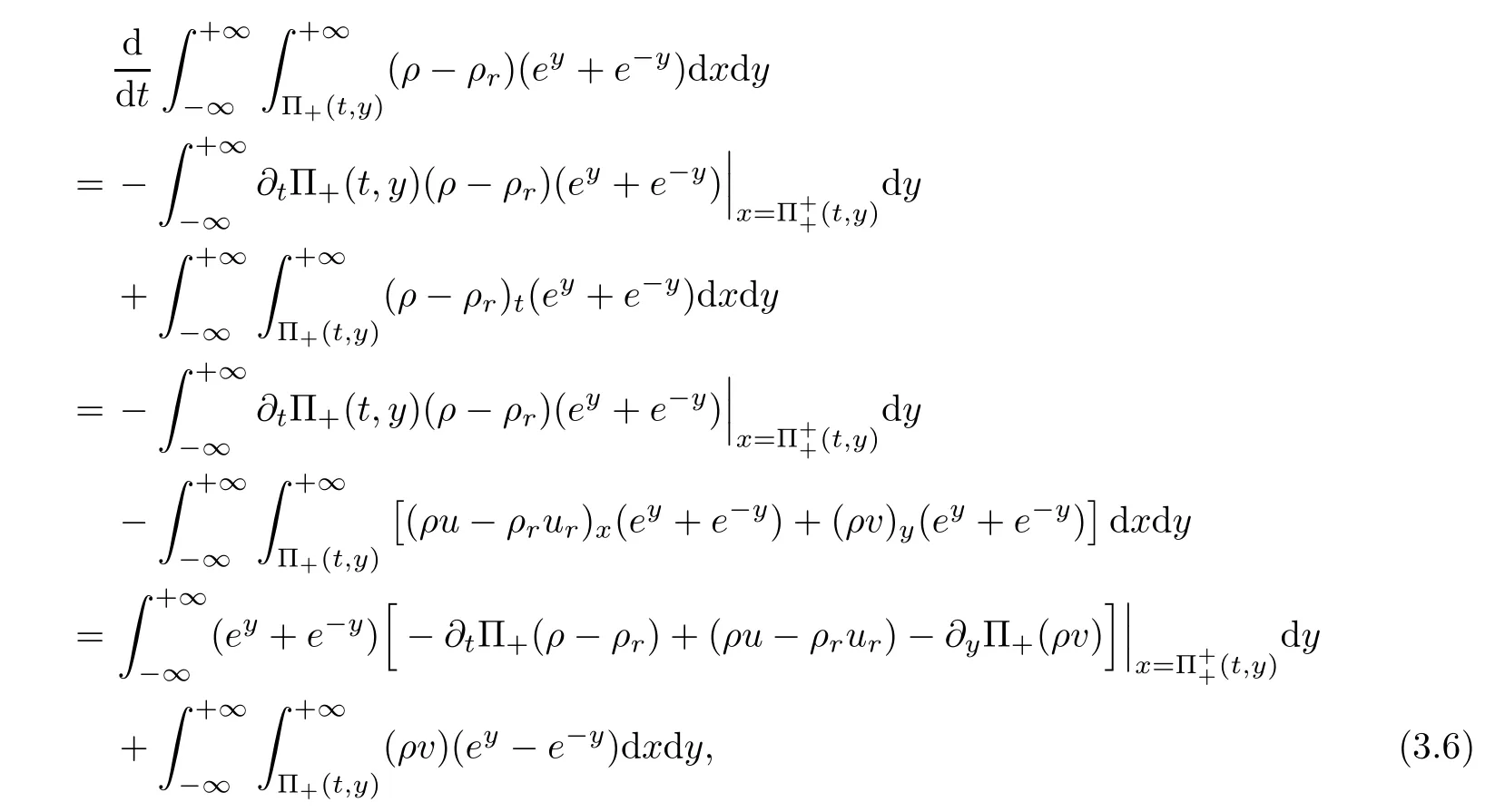
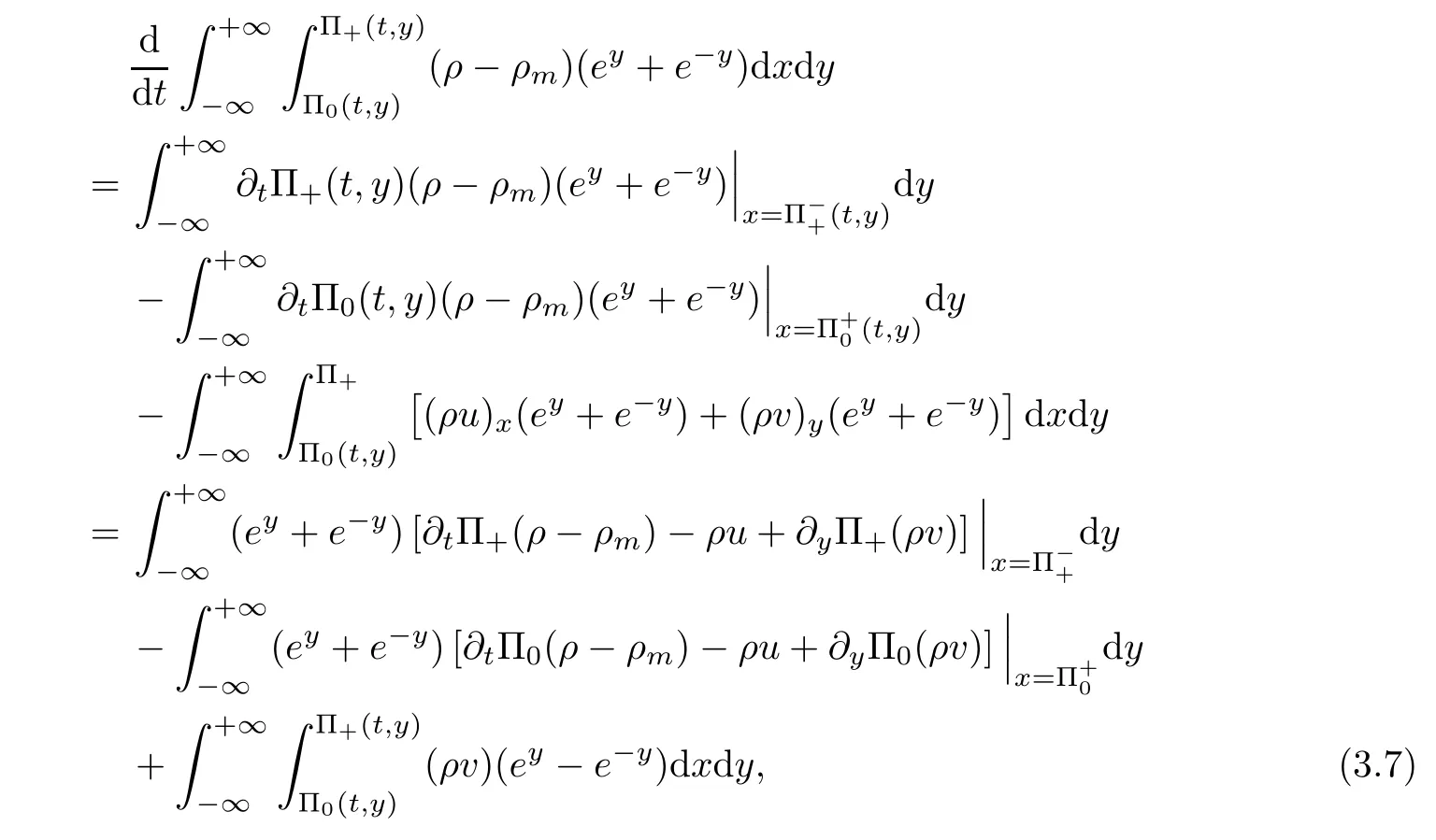
For the integration in the regions Π-(t,y)<x<Π0(t,y) and-∞<x<Π-(t,y),similarly,we have the following results:
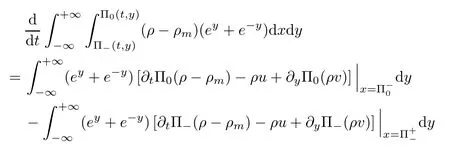

We omit the details for brevity,since the arguments for the two results above are similar to the ones for (3.6) and (3.7).It follows,by adding (3.6)–(3.9) together,that

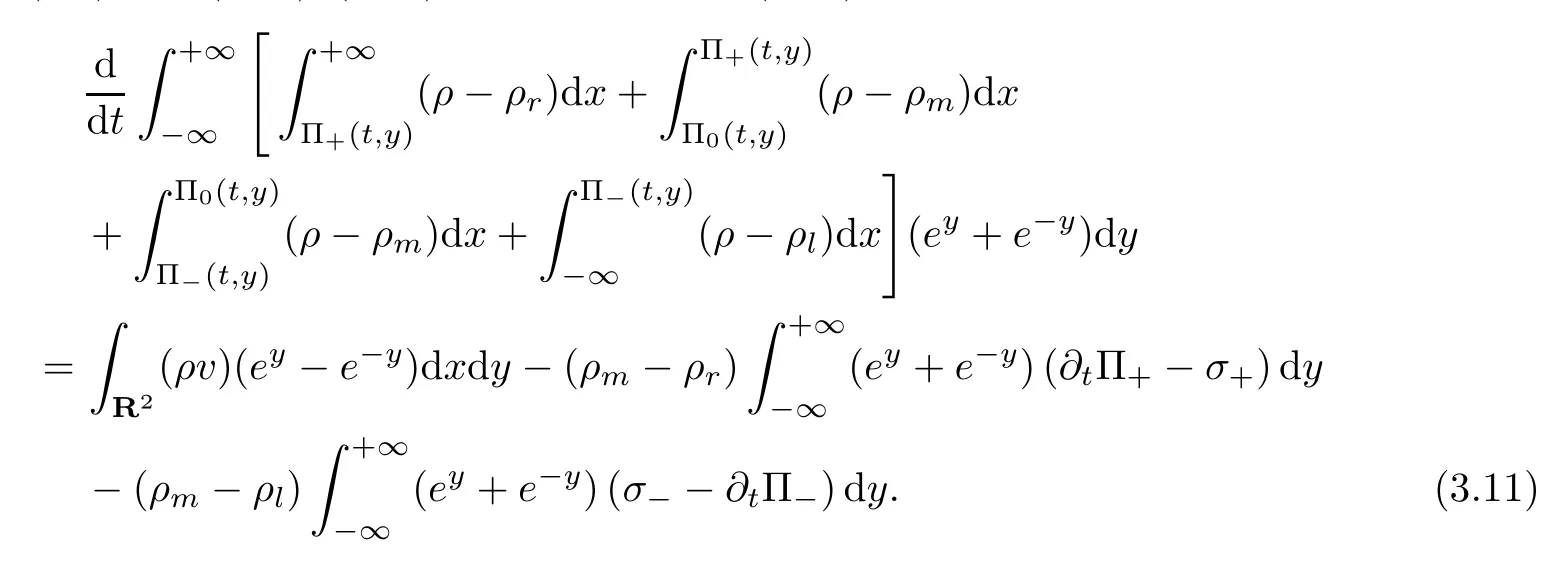
This amounts to (3.3),based on the observation that


Now we are going to show (3.4).As in (3.5),we rewrite the third equation in (2.2) as follows:

As above,we divide the ensuing quantity into four parts such that

The first integration is on the region Π+(t,y)<x<∞.By integration by parts,we have

Similarly,for the other three integrations,after straightforward computations,we have that
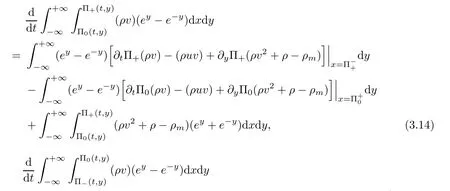
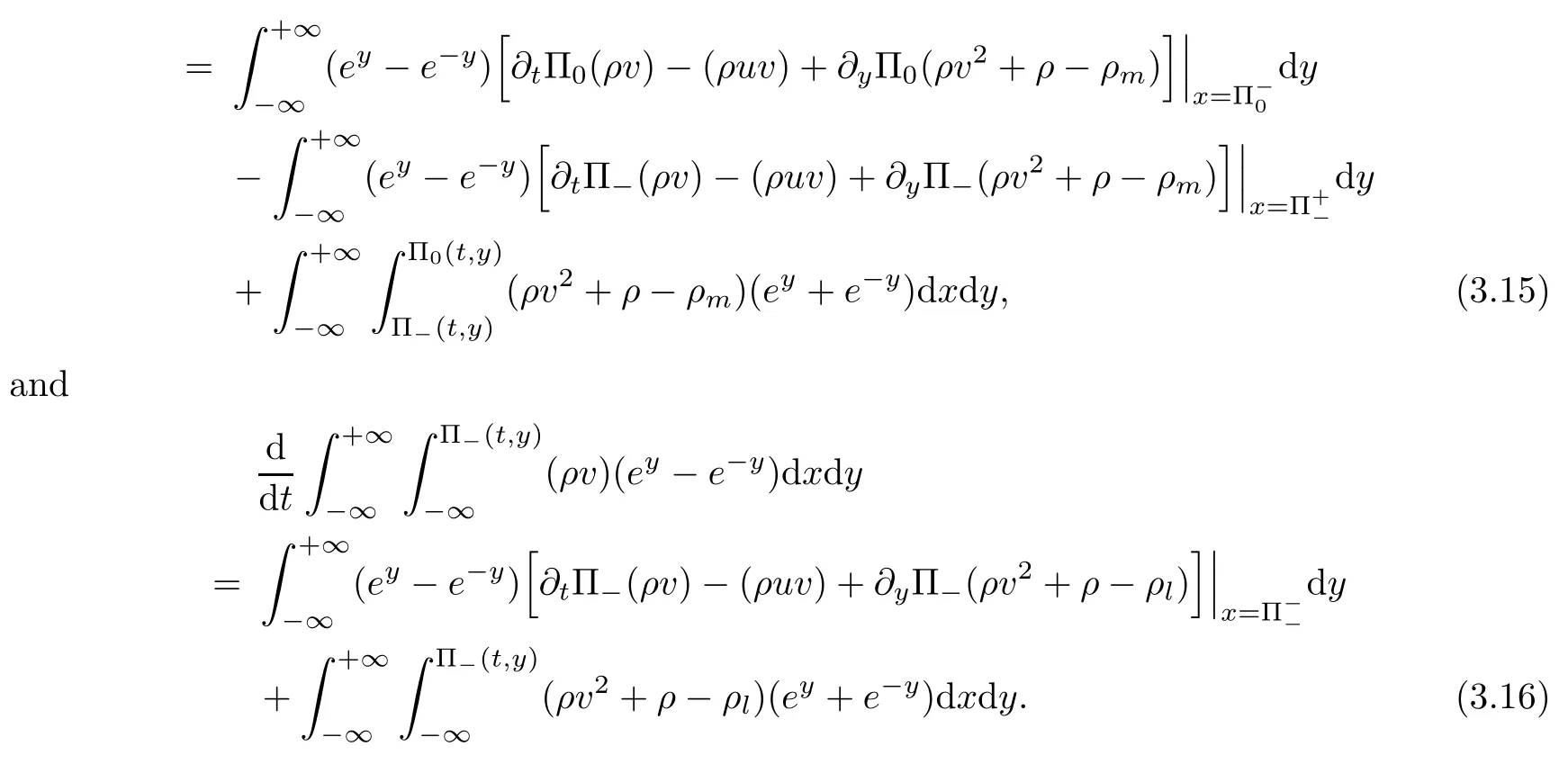
Therefore,it follows,by adding (3.13)-(3.16) together,that
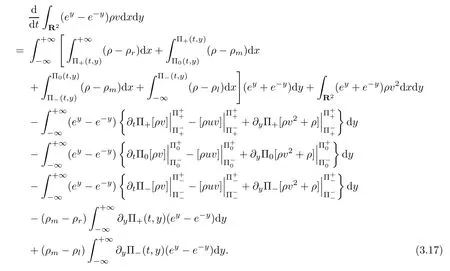
For the last two integrals in (3.17),by integration by parts,we have that


Thus,by the Rankine-Hugoniot conditions (2.8) on Π+,Π0,and Π-,if follows from (3.17)–(3.18) that

Therefore,from (3.11) and (3.19) we obtain (3.3) and (3.4). □
Based on Lemma 3.1,we can now show the proof of Theorem 2.1.
Proof of Theorem 2.1Based on the entropy condition (2.13) and the Rankine-Hugoniot conditions (2.12),we know that

where we have used the assumption thatum=0.Therefore ifεis small,the propagation speed of waves is smaller than 1.Due to the assumption of the support of the initial data in (2.4) and (2.5),there exist constantst0andC0such that the support of the solutionv(t,x,y) satisfies

where the constantC1=(C0-1)t0+1 is independent ofε.

where the last inequality can be obtained by using the variable transformationτ=t-|y|.Here and afterwards,Cdenotes a generic positive constant which is independent ofε.Therefore,it follows from (3.3),(3.4),(3.22) and (3.23) that


As was done for (3.24),it is easy to get from (3.3),(3.4) and (3.27) below that

In fact,by the finite propagation speed of waves,we also know that the support of solutionv(t,x,y) satisfies that,for allt≥0,


Then (3.27) follows by exactly the same argument as the one for (3.24).
By assumption (2.17),we know thatX(0)≥0.Then it follows from (3.25) that

By assumption (2.18),we know thatZ′(0)=Y(0)≥Cε.This means thatZ′(0)=Y(0)≥0,so (3.28) implies,fort≥0,that

Therefore fort≥0,we have that

Also,(3.24) yields that

LettingW=Z′+2Z,we finally get from (3.30) and (3.29) that,fort≥t0,

We note that fort0≥1,we have

because from (2.18),we know thatY(0)≥Cε.Therefore by (3.31),we know that

Therefore,W(t) will blow up before a timeCε-2.This is the lifespan estimate (2.19).□
4 Proof of Theorem 2.2:Three Dimensional Case
In this section,we will prove Theorem 2.2.In order to do this,instead of the test functioney±e-yused in two dimensions,we introduce the following test function:

Test functionF(y) is radially symmetric and satisfies the following properties:

One can refer to[44]for more details regarding the properties of the test functionF(y).Based on the test functionF(y),we can now prove Theorem 2.2.
Proof of Theorem 2.2Let
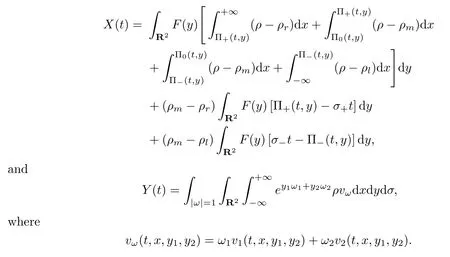
Here (u,v1,v2) represent the velocity.
Multiplying the third and fourth equations in (2.20) byω1andω2,respectively,and then adding them together,we come to a new system:

In a fashion similar to the two dimensional case,by a straightforward computation the same as for the one used in the proof of Lemma 3.1(we omit the long and tedious details for the sake of brevity),we can establish the following ordinary differential system:


For the last inequality above we use the properties thatv1andv2are compactly supported and we employ the finite propogation speed.More preciesly,by the entropy condition,the shock speeds areσ+<1 andσ->-1.When Π-(t,y)≤x≤Π+(t,y),the speed of the characteristic at the boundary of the compact support of the solution is 1,since (u,v1,v2)=(0,0,0).Hence,ifεis sufficiently small,we know that there existsR>0 large enough,not depending on the data,such that the support ofv1andv2satisfies thatx2+r2≤(t+R)2,where
By (2.21),we know thatX(0)≥0,so (4.4) implies that

By (2.22),we know further that thatZ′(0)=Y(0)≥0.Thus it follows from the inequality above that

Next,we need to estimate the last term in (4.4) for whenfor some fixed timewhich is independent ofε.However,unlike for the two dimensional case,things here have to be done in a different way.By (4.1),we have

Finally,lettingW=Z′+2Z,from (2.21),(4.4) and (4.5),we have that

Without loss of the generality,we can assume that.Thus,by (4.5),we have that

By (2.22),we know that there exists a constantCwhich does not depend on the data such thatY(0)≥Cε.Then it follows from (4.7) that

Therefore,W(t) becomes in finite before the time exp(Cε-1). □
AcknowledgementsPart of this work was finished when the first author visited Prof.Zhouping Xin,and he wants to express his sincere thanks for the kind invitation and warm hospitality.
 Acta Mathematica Scientia(English Series)2022年3期
Acta Mathematica Scientia(English Series)2022年3期
- Acta Mathematica Scientia(English Series)的其它文章
- BOUNDEDNESS AND EXPONENTIAL STABILIZATION IN A PARABOLIC-ELLIPTIC KELLER–SEGEL MODEL WITH SIGNAL-DEPENDENT MOTILITIES FOR LOCAL SENSING CHEMOTAXIS*
- ABSOLUTE MONOTONICITY INVOLVING THE COMPLETE ELLIPTIC INTEGRALS OF THE FIRSTKIND WITH APPLICATIONS*
- THE ∂-LEMMA UNDER SURJECTIVE MAPS*
- PARAMETER ESTIMATION OF PATH-DEPENDENT MCKEAN-VLASOV STOCHASTIC DIFFERENTIAL EQUATIONS*
- ESTIMATES FOR EXTREMAL VALUES FOR A CRITICAL FRACTIONAL EQUATION WITH CONCAVE-CONVEX NONLINEARITIES*
- THE SYSTEMS WITH ALMOST BANACH-MEAN EQUICONTINUITY FOR ABELIAN GROUP ACTIONS*
